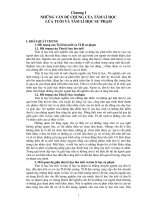tài liệu – tâm lý học vb2k04
Bạn đang xem bản rút gọn của tài liệu. Xem và tải ngay bản đầy đủ của tài liệu tại đây (822.09 KB, 38 trang )
<span class='text_page_counter'>(1)</span><div class='page_container' data-page=1>
Attachment Theory
Attachment Theory
Nunavik counselling and social work
training program
</div>
<span class='text_page_counter'>(2)</span><div class='page_container' data-page=2>
Definition
Definition
<b>Attachment theory</b>
is a theory (or group
of theories) about the psychological concept of
attachment: the tendency to seek closeness to another
person and feel secure when that person is present.
The most important tenet of attachment theory is that
a young child needs to develop a relationship with at
least one primary caregiver for social and emotional
development to occur normally.
</div>
<span class='text_page_counter'>(3)</span><div class='page_container' data-page=3>
Definition
Definition
Attachment is a life-long, distinct behavioral system
whose goal is proximity to the primary caretaker. In
infancy this is accomplished through contact comfort.
Healthy attachment brings love, security, and joy;
unhealthy attachment brings anxiety, grief, and
depression.
unhealthy attachment brings anxiety, grief, and
depression.
All humans form attachments to their primary caregivers
in order to survive. (Bowlby, 1982 & 1988).
</div>
<span class='text_page_counter'>(4)</span><div class='page_container' data-page=4>
Key concept
Key concept
The attachment theory was built by observing situation
(Ainsworth and Bell in 1970).
Name
<i><b>the strange situation</b></i>
The strange situation classification is an assessment
technique in order to investigate how attachments
might vary between children.
</div>
<span class='text_page_counter'>(5)</span><div class='page_container' data-page=5>
Strange situation
Strange situation
Each situation comprised the following stages:
Mother and child enter the room.
Mother and child are left alone; child can play with the toys.
A stranger enters the room; talks to the mother.
Stranger approaches the child with a toy.
Mother leaves stranger alone in the room; stranger engages
the child with toys.
Mother leaves stranger alone in the room; stranger engages
the child with toys.
Mother returns; child’s response is noted.
Child is left in the room on its own.
Stranger returns, tries to engage the child.
Mother returns; child’s response is noted.
The stranger leaves.
</div>
<span class='text_page_counter'>(6)</span><div class='page_container' data-page=6>
Strange situation
Strange situation
The observers looked at four particular
behaviours:
Separation anxiety
The infant’s willingness to explore
The infant’s willingness to explore
Stranger anxiety
</div>
<span class='text_page_counter'>(7)</span><div class='page_container' data-page=7>
What they found
What they found
Based on their observations, Ainsworth and Bell found that
66% of infants were <b>securely attached</b>: these infants
explored the unfamiliar room, were subdued when the
mother left and pleased to see her when she returned. They
were a little wary of the stranger but were friendly toward the
stranger when the mother was present.
The healthiest form of attachment is <b>securely attached</b>. Children
The healthiest form of attachment is <b>securely attached</b>. Children
who are securely attached are comfortable with social interaction
and actively seek it out. The child is able to function independently
because the caregiver acts as a secure base.
To put it another way, the child feels confident in going to nursery
or school because they know their caregiver will return for them.
</div>
<span class='text_page_counter'>(8)</span><div class='page_container' data-page=8>
<b>Insecurely attached</b>
<b>Insecurely attached</b>
..
These children reacted in quite distinct ways:
1.<b>Avoidant insecure</b> children, who made up 22% of the sample, were
not bothered whether their mother was there or not and were not
enthusiastic on her return.
2.<b>Resistant insecure</b> children accounted for 12% of the sample and
2.<b>Resistant insecure</b> children accounted for 12% of the sample and
showed intense distress when their mother was absent. The infant
also rejected the mother on her return.
</div>
<span class='text_page_counter'>(9)</span><div class='page_container' data-page=9>
<b>The importance of </b>
<b>attachment and </b>
<b>meeting the emotional </b>
<b>needs of young children </b>
<b>and their parents.</b>
According to attachment
theory our first
relationship with our
carers acts as a lifelong
template, moulding and
shaping our capacity to
enter into, and maintain,
enter into, and maintain,
successful subsequent
relationships with family,
friends and partners.
It is believed that these
early and powerful
</div>
<span class='text_page_counter'>(10)</span><div class='page_container' data-page=10>
<b>Attachment signals</b>
<b>Attachment signals</b>
As children grow, indeed for all their lives, they adapt to
As children grow, indeed for all their lives, they adapt to
attachment signals and behaviours in an age
attachment signals and behaviours in an age--appropriate way to
appropriate way to
make emotional connection to others in order to:
make emotional connection to others in order to:
Behave in a socially appealing
manner.
Approach, seek out and keep
near to significant others for
near to significant others for
reassurance when fearful or
anxious.
</div>
<span class='text_page_counter'>(11)</span><div class='page_container' data-page=11>
<b>Attachment styles</b>
<b>Attachment styles</b>
Research has shown that whether our emotional needs are met or
responded to in the first years of life can have a long-term effect into
adulthood.
This is described as having a
<i><b>secure</b></i>
or<i><b>insecure attachment</b></i>
.In addition it has been found that attachment ‘styles’ can often be
In addition it has been found that attachment ‘styles’ can often be
passed on from one generation to the next.
</div>
<span class='text_page_counter'>(12)</span><div class='page_container' data-page=12>
<b>Secure attachment</b>
<b>Secure attachment</b>
A secure attachment develops when there is a healthy
reciprocal relationship between child and carer.
Social interaction is characterised by fun and playfulness
and the child’s need for comfort when anxious or
distressed is met quickly and effectively.
distressed is met quickly and effectively.
</div>
<span class='text_page_counter'>(13)</span><div class='page_container' data-page=13>
<b>Secure attachment</b>
<b>Secure attachment</b>
When they become adults, securely attached children are able to
enter into reciprocal relationships and have an expectation that
their needs will be met and that they will be able to meet the
needs of others.
They have the capacity to show emotional connection through
empathy or ‘mind mindedness’, are able to talk about their feelings,
and are familiar with a wide emotional repertoire in both
themselves and others.
and are familiar with a wide emotional repertoire in both
themselves and others.
Securely attached children have internalised in early childhood the
key elements of positive relationship building.
</div>
<span class='text_page_counter'>(14)</span><div class='page_container' data-page=14>
<b>Ambivalent attachment</b>
<b>Ambivalent attachment</b>
Children experience ambivalent attachment when they are never
quite sure whether their carers will meet their need for reassurance
or comfort.
The parent may sometimes respond to distress and anxiety or may
sometimes ignore it.
There is a lack of predictability in the behaviour of the carer that
makes the child feel `all over the place’.
The child often feels distressed but has no confidence that his or her
distress will be heard.
This form of attachment is particularly prevalent in families where
there are mental health problems or issues with alcohol or
</div>
<span class='text_page_counter'>(15)</span><div class='page_container' data-page=15>
<b>Ambivalent attachment</b>
<b>Ambivalent attachment</b>
Ambivalent attachment in children is often perpetuated
by producing adults who are prone to mental health
problems such as depression, anxiety and eating
disorders.
</div>
<span class='text_page_counter'>(16)</span><div class='page_container' data-page=16>
<b>Disorganised attachment</b>
<b>Disorganised attachment</b>
Disorganised attachment occurs when children send out attachment
signals but these are not received or responded to appropriately by
the parent or carer.
Sometimes the parent appears unaware of the child’s needs.
This attachment style can occur when the parent has many
unresolved emotional issues from his or her own past or has no
unresolved emotional issues from his or her own past or has no
emotional resources to draw on due to mental health problems or a
traumatic life event occurring during the first years of the child’s life.
Alternatively, and much more seriously, disorganised attachment can
occur when the parent is a threat to the child through abusive
</div>
<span class='text_page_counter'>(17)</span><div class='page_container' data-page=17>
<b>Disorganised attachment</b>
<b>Disorganised attachment</b>
Children with disorganised attachment often fail to thrive and may
have developmental delay.
Young children will inevitably show signs of emotional and
behavioural difficulties from an early age by demonstrating aggressive,
disruptive or withdrawn behaviours both at home and in the early
year’s environment.
year’s environment.
Disorganised attachment in infancy has been linked by both
longitudinal and retrospective studies to a number of mental health
problems and personality disorders.
</div>
<span class='text_page_counter'>(18)</span><div class='page_container' data-page=18>
<b>Disorganised attachment</b>
<b>Disorganised attachment</b>
In adulthood there is an increased susceptibility to
</div>
<span class='text_page_counter'>(19)</span><div class='page_container' data-page=19>
Early year’s practitioner
Early year’s practitioner
As early year’s practitioners we need to be aware that all children
have complex emotional needs that have to be met in a number of
different ways.
When children’s relationship needs are met they feel secure, happy
and confident.
and confident.
Equally, when their emotional needs fail to be met children can feel
insecure, unhappy and lacking in confidence.
</div>
<span class='text_page_counter'>(20)</span><div class='page_container' data-page=20>
Reflective Activity
-What do you
think of the
children and their
type of
attachment?
-What trauma
they have
suffered?
-What is the
emotion you
experience about
the Kids in the
movie?
- What are the
emotions you
experienced with
regard to adult in
- Looking at the
situation and
status of children
how can you
analyze the
situation through
other
developmental
theory?
</div>
<span class='text_page_counter'>(21)</span><div class='page_container' data-page=21>
<b>Key emotional needs</b>
<b>Key emotional needs</b>
There are 10 key emotional needs that all human
beings have a need for:
Attention
Acceptance
Appreciation
Encouragement
Encouragement
Affection Reflective activity
Respect
Support
Comfort
</div>
<span class='text_page_counter'>(22)</span><div class='page_container' data-page=22>
Attention
Attention
<i><b>Attention</b></i>
needs are met by taking a focused interest in
thoughts, feelings and activities.
</div>
<span class='text_page_counter'>(23)</span><div class='page_container' data-page=23>
Acceptance
Acceptance
<i><b>Acceptance</b></i> needs are met through accepting people for just who
they are at any given moment in time without judgement.
Children need to know that they are accepted even when they exhibit
challenging or difficult behaviour and that there is always forgiveness
and a new beginning.
Acceptance means not comparing one child with another in whatever
Acceptance means not comparing one child with another in whatever
area. It means allowing the child their own individuality and uniqueness
so they grow in their sense of self.
<b>Families need </b>to be accepted whatever their socio-economic status,
</div>
<span class='text_page_counter'>(24)</span><div class='page_container' data-page=24>
Appreciation
Appreciation
<i><b>Appreciation</b></i> is shown by giving positive celebratory feedback on
big and small things. Telling children what it is they have done well
and why you are proud of them means their sense of purpose is
enhanced.
Achievements should be celebrated in whatever area. A lovely smile
or a kind act are as worthy of appreciation as tidying up the toys.
Some children like public acclamations of success; others prefer the
quiet word of appreciation – just like adults!
</div>
<span class='text_page_counter'>(25)</span><div class='page_container' data-page=25>
Encouragement
Encouragement
<i><b>Encouragement</b></i> involves ‘cheerleading’ through motivating and
empowering from the sidelines thereby giving children a sense of
your strong belief in their abilities to meet the challenges of learning,
playing and growing.
Stretch them a little bit further than they thought they could go.
Encourage them when the going gets tough and resolve falters.
</div>
<span class='text_page_counter'>(26)</span><div class='page_container' data-page=26>
Affection
Affection
<i><b>Affection</b></i>
involves using the power of physical touch to
communicate our care and support.
Although we obviously need to keep within appropriate
boundaries it is vitally important to reach out to children
with a simple pat on the hand or touch on the arm.
with a simple pat on the hand or touch on the arm.
</div>
<span class='text_page_counter'>(27)</span><div class='page_container' data-page=27>
Respect
Respect
<i><b>Respect</b></i>
for young children means seeing them within
the context of their whole life experiences both at
home and in the setting and giving them the dignity that
comes from growing in independence and self.
</div>
<span class='text_page_counter'>(28)</span><div class='page_container' data-page=28>
Support
Support
<i><b>Support</b></i> is necessary when children are finding life challenging in
whatever way, whether it is socially, emotionally or in tackling their
learning – they need to feel help is just there ready to be asked for.
Children need to know that we will put ourselves out and be
prepared to go that extra mile sometimes too.
This gives a sense of working and growing alongside others in the
knowledge that they are not alone.
</div>
<span class='text_page_counter'>(29)</span><div class='page_container' data-page=29>
Comfort
Comfort
<i><b>Comfort</b></i>
is needed when children are sad, upset or
distressed.
They need to know that their feelings will be acknowledged
and heard.
Hurt needs to be soothed through empathetic listening or
Hurt needs to be soothed through empathetic listening or
appropriate physical touch.
A time to recover gives dignity and space.
</div>
<span class='text_page_counter'>(30)</span><div class='page_container' data-page=30>
Approval
Approval
<i><b>Approval</b></i> is received by giving regular verbal feedback, treats and
rewards for positive behaviour, actions and activities.
Speaking highly of children in their presence and to others allows
them to feel proud of themselves and builds self-concept,
internalising a sense of worth.
Approval should be about ‘who children are’ as well as what they
do.
</div>
<span class='text_page_counter'>(31)</span><div class='page_container' data-page=31>
Security
Security
<i><b>Security</b></i> is crucial to allow children to feel held and contained safely.
Clear expectations and boundaries that are systematically carried
through in a fair way provide the foundation of security.
Children also gain security through experiencing a consistency of
routines and from seeing adults work in a harmonious and integrated
Children also gain security through experiencing a consistency of
routines and from seeing adults work in a harmonious and integrated
way.
They also need to know when there will be changes in routines, or
when experiences will be coming to an end so that a pathway through
these can be negotiated in a seamless way.
<i>Equally we need to have clear professional boundaries with parents and be </i>
</div>
<span class='text_page_counter'>(32)</span><div class='page_container' data-page=32>
In order to support the emotional wellbeing of
children it is necessary to think through different
and complimentary ways in which we can meet the
10 top emotional needs effectively.
We also need to make sure that we are looking
after ourselves and we are meeting our own
emotional needs through the input of family, friends
and colleagues. It is only when we have this ‘input’
and colleagues. It is only when we have this ‘input’
that we can provide the necessary ‘output’.
This is why working with parents can have such an
important positive effect on empowering and
</div>
<span class='text_page_counter'>(33)</span><div class='page_container' data-page=33>
Attachment vs Communication
Attachment vs Communication
The capacity to communicate with others is at the heart of human
experience.
We use language, thought, feelings, creativity and movement to let
others know about ourselves.
Through that communication, we also develop our capacity to
Through that communication, we also develop our capacity to
understand others.
The way we come to communicate and understand is shaped by our
early experience of relationships – the context in which we begin to
learn about, and make sense of the world.
Good early attachment experiences facilitate the capacity to
</div>
<span class='text_page_counter'>(34)</span><div class='page_container' data-page=34>
Attachment vs communication
Attachment vs communication
<b>Secure base</b>
A secure base provides the infant with a safe place from
which to explore the world, but return to when he or she
feels threatened.
The aim of attachment behaviour is sufficient proximity or
contact to ensure that we always feel secure. The infant
and mother negotiate a way of relating.
</div>
<span class='text_page_counter'>(35)</span><div class='page_container' data-page=35>
Attachment vs communication
Attachment vs communication
<b>Securely attached</b>
Secure enough attachment fosters the capacity to resolve distress.
The experience of empathy – having one’s feelings and experiences
understood by another – allows the development of self awareness.
From there we evolve a language to communicate emotional states.
From there we evolve a language to communicate emotional states.
Someone who has experienced a secure attachment is, as being
available, responsive, and helpful.’
This gives rise to a complementary model of himself or herself as ‘a
potentially loveable and valuable person’. As a result, he or she is likely
to ‘approach the world with confidence.’ This makes it possible to
</div>
<span class='text_page_counter'>(36)</span><div class='page_container' data-page=36>
<b>Securely attached</b>
An outcome of fears being understood, soothed and put into
words and thoughts by another is that the infant becomes able to:
experience being understood
develop an understanding of self and become self-aware
develop an understanding of self and become self-aware
become able to recognise feelings in others
develop his or her own coping mechanism in the face of
</div>
<span class='text_page_counter'>(37)</span><div class='page_container' data-page=37>
Attachment vs communication
Attachment vs communication
<b>Insecure attachment</b>
When adverse experiences of early attachment are not relieved by
more positive relationships with others, the consequences for
communication, behaviour and learning are negative.
Insecurely attached children struggle to find the words to identify
experiences buried in infancy, before any capacity to explore or
express experience with words and actions had evolved.
express experience with words and actions had evolved.
These experiences are unconsciously known but never understood.
Memories of them do not remain in the past, but become actions in
the here and now.
</div>
<span class='text_page_counter'>(38)</span><div class='page_container' data-page=38>
Attachment vs communication
Attachment vs communication
<b>Withdrawn children</b>
Some children communicate their struggle by the way they seek to avoid
drawing attention to themselves.
Social withdrawal can be a way of letting others know that other
preoccupations have ‘taken over’. Such a communication is easy to overlook in
a demanding classroom. Most teachers’ capacity to respond is taken up by
those, usually boys, who are acting out and behaving in disruptive ways.
those, usually boys, who are acting out and behaving in disruptive ways.
Children who have not been given the opportunity to process adverse
experiences, within the context of a relationship with a sensitive carer who can
understand their fear and transform this into words and thought, are left with
insufficient resources to resolve the challenges and traumas that almost
inevitably occur.
</div>
<!--links-->









